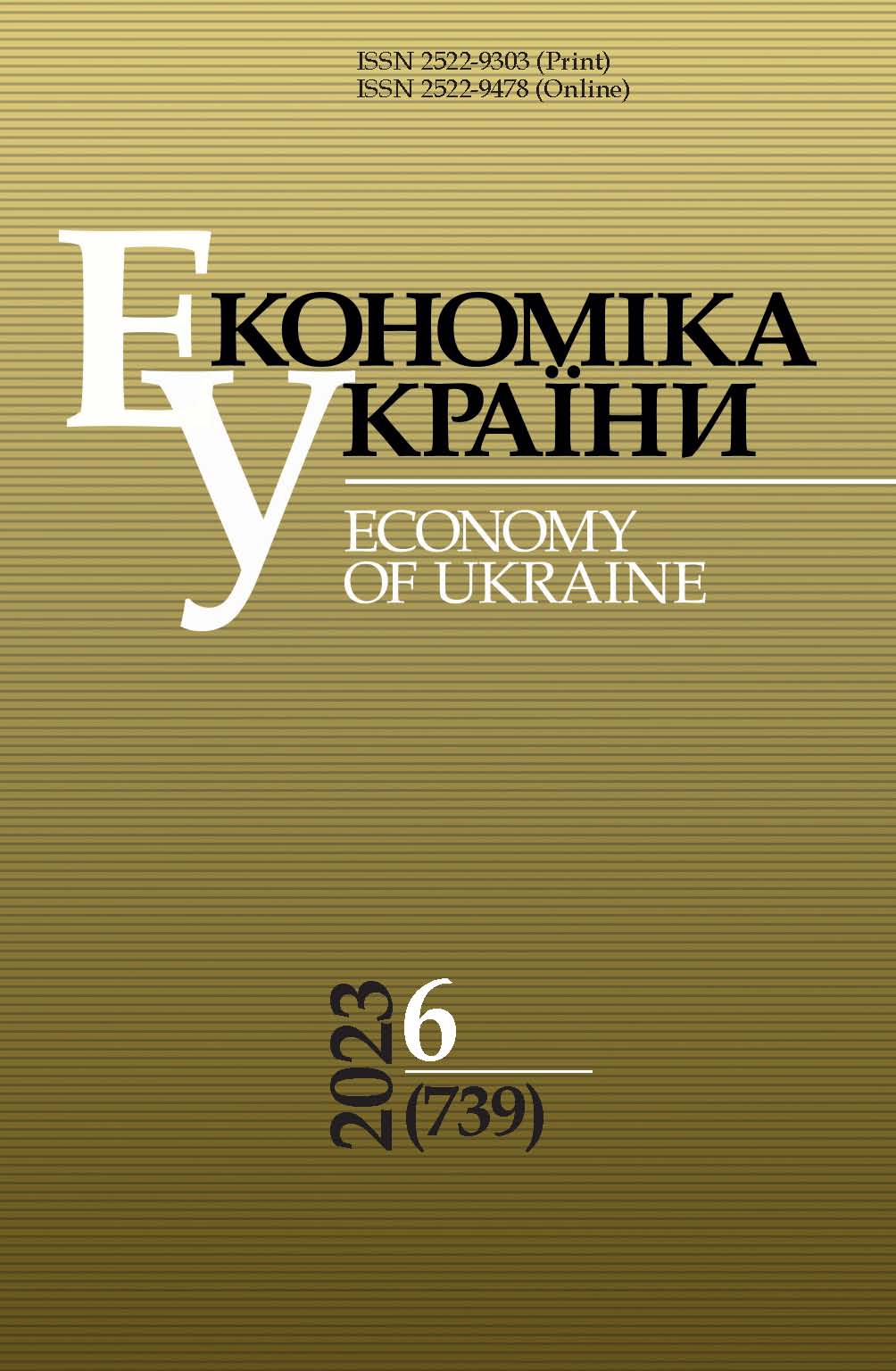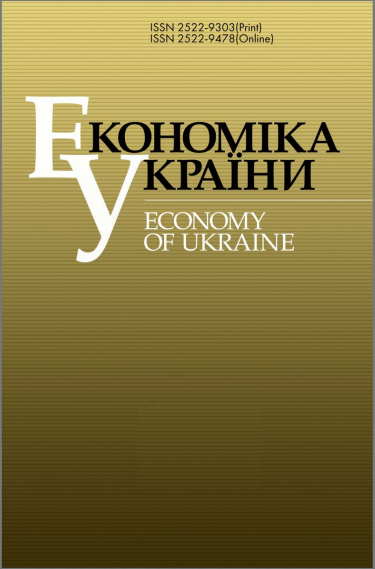INTERNATIONAL EXPERIENCE OF POST-WAR INDUSTRY RECOVERY
DOI:
https://doi.org/10.15407/economyukr.2023.06.023Keywords:
institutional transformations; macroeconomic stabilization; post-war reconstruction; industry;Abstract
The contours of policy for macroeconomic stabilization and industrial development that was implemented for post-war recovery by the countries of Europe, Asia, and Africa, which experienced wars and conflicts in the 20th and 21st centuries, are outlined; its historical and economic background is revealed. The factors that determined the industrial revival trajectory in each country are singled out: global, institutional, macroeconomic, resource, innovative and technological, etc. The results of the "Marshall Plan" implementation in European countries and Japan, as well as other types of international aid for the affected countries, are evaluated. The multiplicity of state’s behavioral patterns, which determined the choice of specific direction of industrial revival, is noted: restructuring of industrial sector (Europe), innovative technological modernization (Israel, Asian countries), large industrial projects (Egypt) or the state’s detachment from significant intervention in structural transformations in the economy (Western Balkans countries). The determining role of favorable business climate formation in the post-war period for stimulating the inflow of investments in industrial and other sectors of economy, as well as positive impact of state investments in the development of physical infrastructure and innovation ecosystem, is revealed.
It is determined that the post-war recovery of industry took place quickly and had stable results in countries where market principles of economic management and stable institutions were formed (Western Europe); in Asian countries, the recovery process had short-term successes after World War II, but industrial modernization actually took decades due to differences in the economic development strategies of different governments. Insufficient attention of the state to the industrial sector was often the cause of deindustrialization and weak innovative development of the state (Western Balkans countries).
It is established that the expected international financial and technical assistance was rarely allocated directly for the support of the industrial sector, which encouraged the states to accumulate their own resources, to preserve the state form of ownership of large industrial objects contrary to the goals of privatization, or to create conditions for attracting foreign investments, forming an export-oriented model of economy.
References
Sukhyi O. History of Belgium. Lviv, 2005 [in Ukrainian].
Economic Growth in Europe since 1945. N. Crafts, G. Toniolo (Eds.). Cambridge University Press, 1996.
Judt T. Postwar: A History of Europe Since 1945. Kyiv, 2020 [in Ukrainian].
Pihkala E. The Political Economy of Post-War Finland, 1945-1952. Opiskelijakirjaston verkkojulkaisu. University of Helsinki, 2004. URL: helda.helsinki.fi/bitstream/handle/10224/3553/pihkala26-47.pdf;jsessionid=75315298D835549C5B78C51FACBD1540?sequence=1
Jäntti M., Vartiainen J. What Can Developing Countries Learn from Finland's Industrial Transformation? UNU WIDER. Blog, October 2009. URL: www.wider.unu.edu/publication/what-can-developing-countries-learn-finland%E2%80%99s-industrial-transformation (accessed on: 15.01.2023).
Power in Europe? Vol. I. Great Britain, France, Italy and Germany in a Postwar World, 1945-1950. J. Becker, F. Knipping (Eds.). De Gruyter, 2011.
Khudokormov A.G. "Economic miracle" in France: Formation and Results of the Dirigisme Model in 1944-1973. The World of New Economy, 2019, No. 13(2), pp. 55-69 [in Russian].
doi.org/10.26794/2220-6469-2019-13-2-55-69
Ivanov S. Economic recovery and development of countries after armed conflicts and wars: Ukraine's opportunities that have not lost yet. Economy of Ukraine, 2019, No. 1 (686), pp. 75-89 [in Ukrainian].
doi.org/10.15407/economyukr.2019.01.075
Smogorzewski K.M. Polish Economy under Soviet Control. The Slavonic and East European Review, 1954, Vol. 32, No. 79, pp. 385-405. URL: www.jstor.org/stable/4204562
Ratajczak M. Polish Economics and the Polish Economy: A Study for the Twentieth Anniversary of Transition in Poland. The History of Economic Thought, 2009, Vol. 51, No. 2. URL: www.jstage.jst.go.jp/article/jshet/51/2/51_1/_pdf
doi.org/10.5362/jshet.51.2_1
Svezhentseva O. The peculiarities of socialization of the Czechoslovak economy at the end of 1940s and the beginning of 1950s of the 20th century. Scientific Herald of Uzhhorod University. Series: History, 2011, Vol. 26, pp. 167-173 [in Ukrainian].
Bernàšek M. Czechoslovak planning 1945-48. Soviet Studies, 1970, No. 22, Iss. 1, pp. 94-109.
doi.org/10.1080/09668137008410739
Lazarčik G. Economic Growth of Czechoslovakia Since World War II. Vol. 1: Political, international, social and economic aspects. Berlin, Boston, De Gruyter Mouton, 2019, pp. 419-435.
Feiwel G.R. The Inverse Economic Miracle: Sources of Growth and Retrogression in Postwar Czechoslovakia. Economic Development and Cultural Change, 1971, Vol. 19, No. 3.
doi.org/10.1086/450493
Gligorov V., Kaldor M., Tsoukalis L. Balkan Reconstruction and European Integration. The Hellenic Observatory, The European Institute, LSE, 1999. URL: eprints.lse.ac.uk/3319/1/Balkan_Reconstruction_and_European_Integration.pdf
Stevanović S., Milanović M., Milačić S. Problems of the Deindustrialization of the Serbian Economy. Economics of Agriculture, 2013, No. 3, pp. 465-477. doi.org/10.22004/ag.econ.158249
Kuchiki A. Industrial Policy in Asia. Institute of Developing Economies. IDE Discussion Paper, 2007, No. 128. URL: ir.ide.go.jp/?action=repository_uri&item_id=38039&file_id=22&file_no=1
Otsubo N.S. Post-War Development of Japanese Economy. GSID, Nagoya University, 2007. URL: www.gsid.nagoya-u.ac.jp/sotsubo/Postwar_Development_of_the_Japanese%20Economy(Otsubo_NagoyaU).pdf
Fforde A. Economics, History, and the Origins of Vietnam's Post-War Economic Success. Asian Survey, 2009, Vol. 49, No. 3, pp. 484-504.
doi.org/10.1525/as.2009.49.3.484
Hasan Ali. Economic Growth and Industrialization Strategy in Malaysia: Before 1980. Hokudai Economic Papers, 1987, No. 17, pp. 49-70. URL: eprints.lib.hokudai.ac.jp/dspace/bitstream/2115/30736/1/17_P49-70.pdf
Jomo S.K., Siddiqui K. Malaysia's socio-economic transformation in historical perspective. International Journal of Business and General Management, 2012, Vol. 1, Iss. 2, pp. 21-50. URL: core.ac.uk/download/pdf/9840859.pdf
Siriprachai S. The Thai Economy: Structural Changes and Challenges Ahead. Thammasat Economic Journal, 2009, Vol. 27, No. 1, pp. 148-229. URL: so05.tci-thaijo.org/index.php/TER/article/view/136643
Kim K.S. The Korean miracle (1962-1980) revisited: myths and realities in strategy and development. The Helen Kellogg Institute for International Studies, WP#166, 1991. URL: kellogg.nd.edu/sites/default/files/old_files/documents/166_0.pdf
Zholud O. Korea: Causes of the Tremendous Growth. Vox Ukraine, 2017, Apr 03. URL: voxukraine.org/pivdenna-koreya-spravzhni-prichini-grandioznogo-zrostannya/ (accessed on: 16.03.2023) [in Ukrainian].
doi.org/10.15407/ugz2017.04.003
Shih Chien-sheng. Economic Development in Taiwan after the Second World War. Weltwirtschaftliches Archiv, 1968, Bd. 100, pp. 113-134. URL: www.jstor.org/stable/40436626
How Nations Learn: Technological Learning, Industrial Policy, and Catch-up. A. Oqubay, K. Ohno (Eds.). Oxford University Press, 2019.
Liu T.-C. The process of industrialization in Taiwan. The Developing Economies, 1969, Vol. 7, No. 1, pp. 63-81. URL: www.ide.go.jp/library/English/Publish/Periodicals/De/pdf/69_01_04.pdf
doi.org/10.1111/j.1746-1049.1969.tb00799.x
Hwa C.S. Economic Change in Singapore, 1945-1977. Southeast Asian Journal of Social Science, 1979, Vol. 7, No. 1/2, pp. 81-113. URL: www.jstor.org/stable/24490038
doi.org/10.1163/080382479X00054
Hettiarachichi C. The Singaporean Economy: Lessons for Post War Sri Lanka. World Bank Blogs, 2010, May 06. URL: blogs.worldbank.org/endpovertyinsouthasia/singaporean-economy-lessons-post-war-sri-lanka (accessed on: 18.01.2023).
Driver S. The Impact of Industrial Revolutions: China's Rise and the Decline of Japan. E-International Relations, 2015, Dec 13. URL: www.e-ir.info/2015/12/13/the-impact-of-industrial-revolutions-chinas-rise-and-the-decline-of-japan/ (accessed on: 08.02.2023).
Wen Yi. China's Rapid Rise: From Backward Agrarian Society to Industrial Powerhouse in Just 35 Years. Federal Reserve Bank of St. Louis, 2016, Apr 11. URL: www.stlouisfed.org/publications/regional-economist/april-2016/chinas-rapid-rise-from-backward-agrarian-society-to-industrial-powerhouse-in-just-35-years (accessed on: 19.02.2023).
Cheng Ch.-Yu. The Economy of Communist China 1949-1969. Michigan Papers in Chinese Studies, 1971, No. 9. URL: library.oapen.org/bitstream/handle/20.500.12657/41818/9780472902200.pdf?sequence=1
Getz D., Tadmor Z. Israel needs to prepare for tomorrow's science-based industries. UNESCO Science Report "Towards 2030", 2015. URL: en.unesco.org/sites/default/files/usr15_israel_ru.pdf [in Russian].
Khan M., Miller E. The Economic Decline of Egypt after the 2011 Uprising. Atlantic Council Research Report, 2016, Jun 01. URL: www.atlanticcouncil.org/wp-content/uploads/2016/06/Economic_Decline_Egypt_SjC_web060316.pdf
Downloads
Published
How to Cite
Issue
Section
License

This work is licensed under a Creative Commons Attribution-NonCommercial-NoDerivatives 4.0 International License.



